Beating the Odds—Bighorns
By Paul C. Carter
By any measure, hunting mountain sheep is a challenging undertaking. In North America, there are four species of wild sheep and I've been fortunate to have hunted them all multiple times. But the one specimen that is most difficult to take is the Rocky Mountain bighorn. Success rates for guided hunts, even with excellent outfitters in good areas, historically only run around 50%. These odds are significantly lower than those expected while hunting the bighorn's cousins—Dall, Stone and desert sheep.
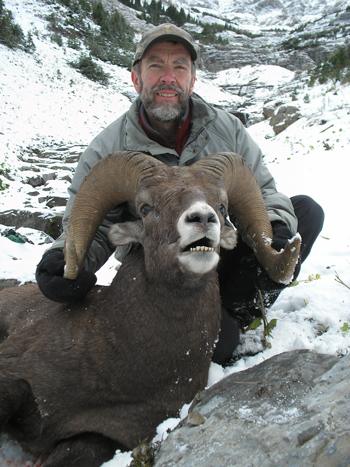
Of course, there are reasons why this is so. There are fewer overall numbers of bighorn rams, they normally congregate in bands containing fewer individuals, and they're usually found in isolated pockets about their range. But in my view, the single greatest reason why bighorns are so difficult to hunt is their propensity to spend significant time in the timber, which is an ever-present and important part of the environment they inhabit. The more time these sheep spend "timbered up," the less visible they are to a hunter's probing eyes. Consequently, they're ultimately harder to find and kill. Bighorns also seem less tolerant of human intrusion—whether detected by sight, smell or hearing—than other wild sheep.
As if sheep hunting weren't difficult enough, some years ago I decided to forsake my modern center-fire gun and pursue these great animals with a muzzle-loading rifle. Besides the one-shot challenge of muzzleloading, in an effort to be more faithful to a primitive ethic, I also opted to forego the advantages a scope offers and hunt with open sights instead. Let's just say I really like to push myself!
In January 2004, I met Jordan and Natasha Aasland, owners of Whiteswan Lake Outfitters, at the Foundation for North American Wild Sheep convention in Reno, Nevada. They outfit bighorn sheep hunts (as well as hunts for several other species) in the East Kootenay region of British Columbia. I was brutally honest with Jordan about my goals, abilities and my weapon of choice. If he thought I was nuts, he was polite enough not to speak his mind. Instead, we made arrangements for a hunt in September 2005, where he would be my guide. Apparently, Jordan wasn't one to shy away from a challenge, either.
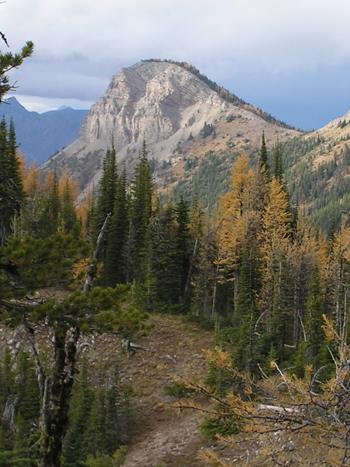
The hunt that followed was very special. We navigated the ups and downs that typically accompany any sheep hunt, including some particularly bad weather. In the end, we connected on a beautiful ram taken from a group of five sheep. Although I was capable of shooting at a much greater distance, I took the ram with an off-hand shot at the improbable range of thirty-five yards. The entirety of the hunt and the quality of the animal made him the best trophy of my hunting career. And despite the difficulties intrinsic to hunting bighorns, as well as the additional self-imposed handicaps, Jordan and I prevailed in the face of great odds.
About a year after our first hunt I was contemplating another bighorn hunt, so I asked Jordan about his schedule and any openings he may have had. His immediate reply to my query was, "Why would you want to do that again?" Jordan's response took me a little off-guard, but I understood why he reacted as he did. Our first hunt together had been so perfect—storybook even—that he feared we could detract from that memory if things didn't work out as well on a subsequent try. And he knew the odds of a repeat performance were decidedly not in our favor on a second go-around. Sensing Jordan's trepidation and the reasons behind it, I responded by saying, "We can't top the first hunt, we can only add to it." Like Jordan, I was under no delusion about the likelihood of being successful on a second try, especially given our good luck on the first hunt. But, that's what hunting is about. No guarantees, just the opportunity to pit yourself against the mountains, the elements and the animal. Sometimes your best efforts are good enough; sometimes they aren't!
So, the stage was subsequently set for October 2008. Three things would be different from the first hunt, though. First, by spending a lot of time shooting, I had extended the effective range with my muzzleloader another 50 yards over the 2005 hunt, to 250 yards. Second, although the division of labor would be the same, Jordan and I would hunt as friends this time. My job, as before, would be to follow Jordan, the always expert guide, wherever he went and then execute the singular responsibility that might determine the outcome of the hunt—make a good trigger pull when the pressure is on. However, our relationship had grown since the first hunt. My wife Janet and I had spent two summers visiting and working with Jordan and Natasha at their lodge in British Columbia, as well as spending significant time with them at the annual Safari Club International conventions in Reno, Nevada. Consequently, we were no longer merely guide and client. Third, Janet would be accompanying me on this trip. Even though she wouldn't be sharing our tent, I expected we would occasionally see each other at the lodge during the course of the hunt. And, I hoped there would be an opportunity for mutual celebration in the immediate aftermath of a successful hunt.
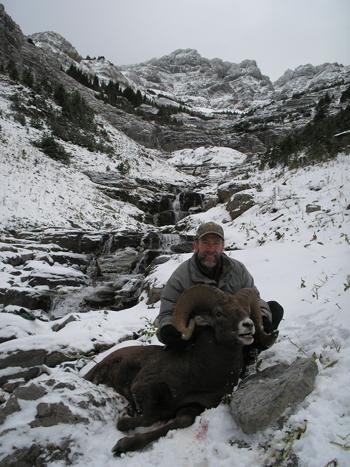
Janet and I arrived in Cranbrook on the evening of September 30th, tired from a full day of traveling. Just as important, my gun and all my hunting gear arrived with us, and in good condition. The next day everyone made the two-hour drive to the main camp north of Whiteswan Lake. Early the following morning, Jordan and I headed to an area at the northern end of his sheep range, which I knew well from our first hunt. After a 2,000 foot climb with full packs, we made camp in the beautiful high-alpine setting.
The rest of the first day was spent glassing nearby semi-wooded basins for sheep. Just prior to dusk we returned to our campsite, where I busied myself glassing the basin below our tent. Almost immediately, I spotted a group of sheep that I thought were rams. Shortly thereafter, Jordan confirmed my finding. I surprised myself with my glassing prowess and I'm sure Jordan was pleasantly pleased. After the first hunt I jokingly told everyone there wasn't a single sheep I missed seeing—after Jordan pointed them out to me. It was too dark to tell if any of the five rams were legal, but we were sure we'd get that opportunity at first light the next morning.
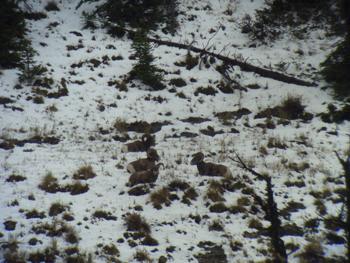
We saw the rams early and often the following day, but no matter how hard he looked, and from whatever angle, Jordan couldn't make the best ram long enough to be legal. That was a shame because they were in a perfect spot to approach within range—very low in the basin and in the sparse timber. For the next two days we checked the adjoining country but found no other rams, although we did see several groups of lambs and ewes. Finally, deteriorating weather and low clouds forced us to bail off the mountain just before things really took a turn for the worse.
Our decision to leave had proven to be a wise one, as all the high country was covered in significant snow the following morning. We were up early and spent the entire day glassing from various strategic vantage points afforded us by the extensive system of logging roads in the area. Although very tiring, our efforts produced two distinct possibilities for the remainder of the hunt. Through Jordan's expertise with the spotting scope, we located one legal ram among a group of four sheep that were residing in a very obscure and heavily timbered area. We had also observed a group of four rams as they crossed a ridge laden in heavy snow, and dropped into a neighboring watershed. Although we couldn't tell if any of these rams were legal, we decided to make them and the area they now occupied the object of our attention for the next few days.
We rose at 4:30 the next morning so we could make the three-hour hike into our next campsite, and still be there in time to catch any sheep in the area up and feeding. After walking most of the way in the dark, we arrived at our outpost and started glassing. Within fifteen minutes, Jordan had the four rams located until they fed out of sight. We needed a better vantage point, so we climbed a nearby mountain to get a better look. Once there, it didn't take Jordan long to determine that not only was one ram legal, but he was quite good. Now, the hunt was really on.
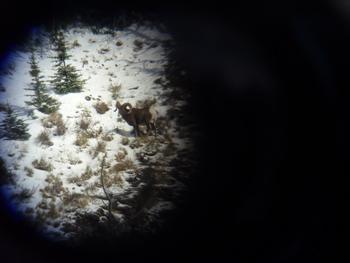
As we waited for the rams to settle in someplace, hopefully somewhere where they could be successfully stalked, we had some clear and present weather issues to contend with. Our location was on a ridge top which we shared with dozens of dead, but still-erect, mature pine trees. And the wind was consistently blowing at thirty-five miles per hour. Before long, things got worse. Angry black clouds spilled in from the north, bringing thunder, lightning, hail and then snow to our lofty perch. For an hour I wasn't sure which eventuality posed the larger threat—being struck by lightning or falling trees.
Finally, the weather improved and later in the day we decided to make a stalk on the rams, even though we weren't exactly sure of their location. Jordan felt they may have been feeding in a basin beyond the next ridgeline. Our approach necessitated a 500 foot descent followed by a 1,000 foot climb—our third of the day. As we neared the ridge the snow became increasingly deep (6"), as well as crusty and noisy due to the falling temperatures. When we peeked into the basin there were no sheep to be seen. Nor were there any tracks visible. The rams were still somewhere below us in the timber. Jordan decided it was too noisy—and consequently too risky—to attempt a blind stalk down the ridgeline, so we backed off. Better to wait for a good opportunity tomorrow than to inadvertently blow them out of the country—without getting a shot—today.
Glassing from our campsite early the next morning, we found the rams in the same general area they occupied the day before. They eventually bedded next to a brook in an area of several short waterfalls. We began our climb towards them, staying mostly in the timber in order to remain unseen. The biggest problem for us was the wind, as the direction was highly variable and unpredictable. We finally attained the same elevation as our quarry and shed our packs for the final stalk. Naturally, it had been some time since we last spied the rams. Jordan quietly said, "We're either going to kill that ram or they'll be gone." My instincts had me nodding in complete agreement.
As we moved in, it soon became obvious that any shot—should I get one—would likely be relatively short. In addition, although the wind was better as we moved along the topographical contour towards the sheep, it wasn't completely reliable. We stayed just at the top of the available timber as we advanced, until our eyes cleared the last hump of real estate preventing a look into the creek bottom. There, a mere seventy-five yards away lay the legal ram, chewing his cud.
We had a large boulder for cover as we contemplated our options. Although we could see the ram's head, I didn't have a clear shot at the ram's body. So concealed by the boulder, I began searching for a more advantageous shooting position. We weren't there five minutes when the wind shifted. I felt the errant breeze. At the same moment Jordan said, "We're busted," as the rams stood upon receiving our scent. I had the hammer on my Thompson/Center Omega already cocked, a solid rest on the rock, and now, a standing broadside target to aim at. I quickly sighted on the ram's chest and pulled the trigger.
A split second after the gun's report Jordan bellowed, "Perfect shot, you got him," as all four rams raced downhill. I was sure my shot had been true and Jordan's confirmation was reassuring, but the rams were moving out of sight and I yearned to see the ram go down as absolute proof of our success. I quickly maneuvered around the uphill side of the boulder to get a better look down the brook at the fleeing sheep. Instantly, the ram fell and slid down the slope, coming to rest at the top of a ten-foot waterfall. A quick glance at my watch revealed it was 11:40 in the morning.
Over the years I've experienced a variety of emotions upon taking a big game animal. Each situation is a little different. Sometimes, an odd mixture of seemingly incompatible feelings rushes to the surface. This time, though, 100% pure joy flooded me as Jordan and I heartily hugged and congratulated each other on our accomplishment.
After retreating for our abandoned gear, we made our way down to the ram. He was magnificent—dark chocolate cape and heavy, broomed full-curl horns—and just as good as my last bighorn. No sheep hunter could ask for more. Once the usual picture taking, caping and butchering were completed, we headed down off the mountain and towards the truck with heavy packs. After six miles of walking and exactly six hours after the ram went down, Jordan and I pulled into the main camp, setting off another round of celebrations—this time with our wives. It was a very happy and a very special occasion—one I'll never forget.
As it turned out, and despite my previously stated expectation, not only had Jordan and I added to our first hunt, but we easily equaled it in both quality and outcome. And although we're capable and committed hunters, we both share the profound understanding and humbling reality that those qualities alone are not always sufficient to succeed in harvesting an animal. Jordan and I had indeed beaten the odds for a second time. Of greater importance are the shared efforts and lasting memories that come from the pursuit of, and good fortune in taking, a great bighorn ram.
Paul C. Carter is a big-game hunter and author who resides in Massachusetts. He has hunted game across North America, taking numerous animals, many with a muzzle-loading rifle. He especially enjoys hunting sheep and whitetail deer. Paul has two Grand Slams of North American wild sheep to his credit, one of which was taken with his iron-sighted muzzleloader. He's also written two books: Tracking Whitetails: Answers to Your Questions and Great Shot! A Guide to Acquiring Shooting Skills for Big-Game Hunters.
By Paul C. Carter
By any measure, hunting mountain sheep is a challenging undertaking. In North America, there are four species of wild sheep and I've been fortunate to have hunted them all multiple times. But the one specimen that is most difficult to take is the Rocky Mountain bighorn. Success rates for guided hunts, even with excellent outfitters in good areas, historically only run around 50%. These odds are significantly lower than those expected while hunting the bighorn's cousins—Dall, Stone and desert sheep.

Of course, there are reasons why this is so. There are fewer overall numbers of bighorn rams, they normally congregate in bands containing fewer individuals, and they're usually found in isolated pockets about their range. But in my view, the single greatest reason why bighorns are so difficult to hunt is their propensity to spend significant time in the timber, which is an ever-present and important part of the environment they inhabit. The more time these sheep spend "timbered up," the less visible they are to a hunter's probing eyes. Consequently, they're ultimately harder to find and kill. Bighorns also seem less tolerant of human intrusion—whether detected by sight, smell or hearing—than other wild sheep.
As if sheep hunting weren't difficult enough, some years ago I decided to forsake my modern center-fire gun and pursue these great animals with a muzzle-loading rifle. Besides the one-shot challenge of muzzleloading, in an effort to be more faithful to a primitive ethic, I also opted to forego the advantages a scope offers and hunt with open sights instead. Let's just say I really like to push myself!
In January 2004, I met Jordan and Natasha Aasland, owners of Whiteswan Lake Outfitters, at the Foundation for North American Wild Sheep convention in Reno, Nevada. They outfit bighorn sheep hunts (as well as hunts for several other species) in the East Kootenay region of British Columbia. I was brutally honest with Jordan about my goals, abilities and my weapon of choice. If he thought I was nuts, he was polite enough not to speak his mind. Instead, we made arrangements for a hunt in September 2005, where he would be my guide. Apparently, Jordan wasn't one to shy away from a challenge, either.

The hunt that followed was very special. We navigated the ups and downs that typically accompany any sheep hunt, including some particularly bad weather. In the end, we connected on a beautiful ram taken from a group of five sheep. Although I was capable of shooting at a much greater distance, I took the ram with an off-hand shot at the improbable range of thirty-five yards. The entirety of the hunt and the quality of the animal made him the best trophy of my hunting career. And despite the difficulties intrinsic to hunting bighorns, as well as the additional self-imposed handicaps, Jordan and I prevailed in the face of great odds.
About a year after our first hunt I was contemplating another bighorn hunt, so I asked Jordan about his schedule and any openings he may have had. His immediate reply to my query was, "Why would you want to do that again?" Jordan's response took me a little off-guard, but I understood why he reacted as he did. Our first hunt together had been so perfect—storybook even—that he feared we could detract from that memory if things didn't work out as well on a subsequent try. And he knew the odds of a repeat performance were decidedly not in our favor on a second go-around. Sensing Jordan's trepidation and the reasons behind it, I responded by saying, "We can't top the first hunt, we can only add to it." Like Jordan, I was under no delusion about the likelihood of being successful on a second try, especially given our good luck on the first hunt. But, that's what hunting is about. No guarantees, just the opportunity to pit yourself against the mountains, the elements and the animal. Sometimes your best efforts are good enough; sometimes they aren't!
So, the stage was subsequently set for October 2008. Three things would be different from the first hunt, though. First, by spending a lot of time shooting, I had extended the effective range with my muzzleloader another 50 yards over the 2005 hunt, to 250 yards. Second, although the division of labor would be the same, Jordan and I would hunt as friends this time. My job, as before, would be to follow Jordan, the always expert guide, wherever he went and then execute the singular responsibility that might determine the outcome of the hunt—make a good trigger pull when the pressure is on. However, our relationship had grown since the first hunt. My wife Janet and I had spent two summers visiting and working with Jordan and Natasha at their lodge in British Columbia, as well as spending significant time with them at the annual Safari Club International conventions in Reno, Nevada. Consequently, we were no longer merely guide and client. Third, Janet would be accompanying me on this trip. Even though she wouldn't be sharing our tent, I expected we would occasionally see each other at the lodge during the course of the hunt. And, I hoped there would be an opportunity for mutual celebration in the immediate aftermath of a successful hunt.

Janet and I arrived in Cranbrook on the evening of September 30th, tired from a full day of traveling. Just as important, my gun and all my hunting gear arrived with us, and in good condition. The next day everyone made the two-hour drive to the main camp north of Whiteswan Lake. Early the following morning, Jordan and I headed to an area at the northern end of his sheep range, which I knew well from our first hunt. After a 2,000 foot climb with full packs, we made camp in the beautiful high-alpine setting.
The rest of the first day was spent glassing nearby semi-wooded basins for sheep. Just prior to dusk we returned to our campsite, where I busied myself glassing the basin below our tent. Almost immediately, I spotted a group of sheep that I thought were rams. Shortly thereafter, Jordan confirmed my finding. I surprised myself with my glassing prowess and I'm sure Jordan was pleasantly pleased. After the first hunt I jokingly told everyone there wasn't a single sheep I missed seeing—after Jordan pointed them out to me. It was too dark to tell if any of the five rams were legal, but we were sure we'd get that opportunity at first light the next morning.

We saw the rams early and often the following day, but no matter how hard he looked, and from whatever angle, Jordan couldn't make the best ram long enough to be legal. That was a shame because they were in a perfect spot to approach within range—very low in the basin and in the sparse timber. For the next two days we checked the adjoining country but found no other rams, although we did see several groups of lambs and ewes. Finally, deteriorating weather and low clouds forced us to bail off the mountain just before things really took a turn for the worse.
Our decision to leave had proven to be a wise one, as all the high country was covered in significant snow the following morning. We were up early and spent the entire day glassing from various strategic vantage points afforded us by the extensive system of logging roads in the area. Although very tiring, our efforts produced two distinct possibilities for the remainder of the hunt. Through Jordan's expertise with the spotting scope, we located one legal ram among a group of four sheep that were residing in a very obscure and heavily timbered area. We had also observed a group of four rams as they crossed a ridge laden in heavy snow, and dropped into a neighboring watershed. Although we couldn't tell if any of these rams were legal, we decided to make them and the area they now occupied the object of our attention for the next few days.
We rose at 4:30 the next morning so we could make the three-hour hike into our next campsite, and still be there in time to catch any sheep in the area up and feeding. After walking most of the way in the dark, we arrived at our outpost and started glassing. Within fifteen minutes, Jordan had the four rams located until they fed out of sight. We needed a better vantage point, so we climbed a nearby mountain to get a better look. Once there, it didn't take Jordan long to determine that not only was one ram legal, but he was quite good. Now, the hunt was really on.

As we waited for the rams to settle in someplace, hopefully somewhere where they could be successfully stalked, we had some clear and present weather issues to contend with. Our location was on a ridge top which we shared with dozens of dead, but still-erect, mature pine trees. And the wind was consistently blowing at thirty-five miles per hour. Before long, things got worse. Angry black clouds spilled in from the north, bringing thunder, lightning, hail and then snow to our lofty perch. For an hour I wasn't sure which eventuality posed the larger threat—being struck by lightning or falling trees.
Finally, the weather improved and later in the day we decided to make a stalk on the rams, even though we weren't exactly sure of their location. Jordan felt they may have been feeding in a basin beyond the next ridgeline. Our approach necessitated a 500 foot descent followed by a 1,000 foot climb—our third of the day. As we neared the ridge the snow became increasingly deep (6"), as well as crusty and noisy due to the falling temperatures. When we peeked into the basin there were no sheep to be seen. Nor were there any tracks visible. The rams were still somewhere below us in the timber. Jordan decided it was too noisy—and consequently too risky—to attempt a blind stalk down the ridgeline, so we backed off. Better to wait for a good opportunity tomorrow than to inadvertently blow them out of the country—without getting a shot—today.
Glassing from our campsite early the next morning, we found the rams in the same general area they occupied the day before. They eventually bedded next to a brook in an area of several short waterfalls. We began our climb towards them, staying mostly in the timber in order to remain unseen. The biggest problem for us was the wind, as the direction was highly variable and unpredictable. We finally attained the same elevation as our quarry and shed our packs for the final stalk. Naturally, it had been some time since we last spied the rams. Jordan quietly said, "We're either going to kill that ram or they'll be gone." My instincts had me nodding in complete agreement.
As we moved in, it soon became obvious that any shot—should I get one—would likely be relatively short. In addition, although the wind was better as we moved along the topographical contour towards the sheep, it wasn't completely reliable. We stayed just at the top of the available timber as we advanced, until our eyes cleared the last hump of real estate preventing a look into the creek bottom. There, a mere seventy-five yards away lay the legal ram, chewing his cud.
We had a large boulder for cover as we contemplated our options. Although we could see the ram's head, I didn't have a clear shot at the ram's body. So concealed by the boulder, I began searching for a more advantageous shooting position. We weren't there five minutes when the wind shifted. I felt the errant breeze. At the same moment Jordan said, "We're busted," as the rams stood upon receiving our scent. I had the hammer on my Thompson/Center Omega already cocked, a solid rest on the rock, and now, a standing broadside target to aim at. I quickly sighted on the ram's chest and pulled the trigger.
A split second after the gun's report Jordan bellowed, "Perfect shot, you got him," as all four rams raced downhill. I was sure my shot had been true and Jordan's confirmation was reassuring, but the rams were moving out of sight and I yearned to see the ram go down as absolute proof of our success. I quickly maneuvered around the uphill side of the boulder to get a better look down the brook at the fleeing sheep. Instantly, the ram fell and slid down the slope, coming to rest at the top of a ten-foot waterfall. A quick glance at my watch revealed it was 11:40 in the morning.
Over the years I've experienced a variety of emotions upon taking a big game animal. Each situation is a little different. Sometimes, an odd mixture of seemingly incompatible feelings rushes to the surface. This time, though, 100% pure joy flooded me as Jordan and I heartily hugged and congratulated each other on our accomplishment.
After retreating for our abandoned gear, we made our way down to the ram. He was magnificent—dark chocolate cape and heavy, broomed full-curl horns—and just as good as my last bighorn. No sheep hunter could ask for more. Once the usual picture taking, caping and butchering were completed, we headed down off the mountain and towards the truck with heavy packs. After six miles of walking and exactly six hours after the ram went down, Jordan and I pulled into the main camp, setting off another round of celebrations—this time with our wives. It was a very happy and a very special occasion—one I'll never forget.
As it turned out, and despite my previously stated expectation, not only had Jordan and I added to our first hunt, but we easily equaled it in both quality and outcome. And although we're capable and committed hunters, we both share the profound understanding and humbling reality that those qualities alone are not always sufficient to succeed in harvesting an animal. Jordan and I had indeed beaten the odds for a second time. Of greater importance are the shared efforts and lasting memories that come from the pursuit of, and good fortune in taking, a great bighorn ram.
Paul C. Carter is a big-game hunter and author who resides in Massachusetts. He has hunted game across North America, taking numerous animals, many with a muzzle-loading rifle. He especially enjoys hunting sheep and whitetail deer. Paul has two Grand Slams of North American wild sheep to his credit, one of which was taken with his iron-sighted muzzleloader. He's also written two books: Tracking Whitetails: Answers to Your Questions and Great Shot! A Guide to Acquiring Shooting Skills for Big-Game Hunters.

